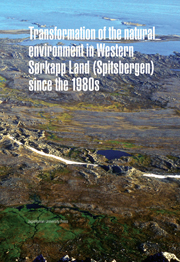Book contents
Glaciation
from Components of natural environment
Published online by Cambridge University Press: 05 September 2014
Summary
Sørkapp Land glaciation is clearly Artic-type for the following two reasons:
1) common presence of permafrost, which is predominantly frozen solid rock and only in the Quaternary deposits consists of ice mixed with rock material of variable granulation,
2) very weak influence of altitude (above sea level) on the distribution and extent of glaciers.
The northern part of western Sørkapp Land (Fig. 3) includes ca. 50 km2 of mountains (seven massifs arranged into two ridges with Lisbetdalen valley between them) without glaciers during all of the Holocene, in spite of the fact that their quite extensive and flattened peaks reach an elevation of 640 m (Ziaja 1992, 1999). This is due to the exceptional local climate described earlier (equally high or lower areas situated a few kilometers further to the east and southeast have been superficially glaciated to a substantial degree).
These areas with expansive glaciers flowing from the glaciated peninsula's interior to the west and south, and with small glaciers on coastal mountain massifs, are not part of western Sørkapp Land. The extent of each glacier marks the natural boundary of the western region. A retreat of this extent is simply a shift of this boundary to the east.
- Type
- Chapter
- Information
- Transformation of the Natural Environment in Western Sorkapp Land (Spitsbergen) since the 1980s , pp. 31 - 32Publisher: Jagiellonian University PressPrint publication year: 2011

